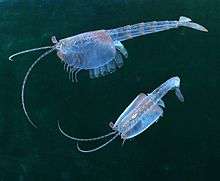Hymenocarina
Hymenocarina is a group of extinct arthropods known from the Cambrian, they possess bivalved carapaces with exposed posteriors, and look superficially like shrimp. They are generally interpreted as stem-crustaceans[1] or mandibulates.[2] They were defined in Aria and Caron (2017) as: "Euarthropods with bivalved carapace covering cephalothoracic region up to a large portion of 27 post-cephalothoracic tagma; plesiomorphically, cephalothorax bearing well-developed antennules and enditic 28 endopod podomeres with well-developed terminal claws; limb basis segmented; posterior tagma with tergo-pleural 29 rings; tailpiece a rounded telson bearing well-developed caudal rami."[2]
| Hymenocarina | |
|---|---|
 | |
| Waptia | |
| Scientific classification | |
| Kingdom: | Animalia |
| Phylum: | Arthropoda |
| Clade: | Pancrustacea |
| Order: | †Hymenocarina Størmer, 1944 |
| Genera | |
| Synonyms | |
|
Canadaspidida Novozhilov in Orlov, 1960 | |
References
- Vannier, Jean; Aria, Cédric; Taylor, Rod S.; Caron, Jean-Bernard. "Waptia fieldensis Walcott, a mandibulate arthropod from the middle Cambrian Burgess Shale". Royal Society Open Science. 5 (6): 172206. doi:10.1098/rsos.172206.
- Aria, Cédric; Caron, Jean-Bernard (2017-04-26). "Burgess Shale fossils illustrate the origin of the mandibulate body plan". Nature. 545 (7652): 89–92. doi:10.1038/nature22080. ISSN 0028-0836.
This article is issued from Wikipedia. The text is licensed under Creative Commons - Attribution - Sharealike. Additional terms may apply for the media files.